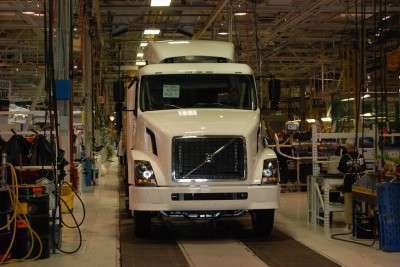
During a recent conversation with industry journalists, Denny Slagle, president and chief executive officer of Volvo Trucks North America, touched on a number of industry topics, including meeting with President Obama and U.S. Transportation Secretary Ray LaHood on boosting fuel economy standards for heavy-duty trucks, the success of Volvo’s 2010 engine family and even Volvo’s future in the North American marketplace.
Commenting on his meeting with Obama and LaHood, Slagle noted that a dialogue had been established, although he admitted it would be nice to have a “breather” to recoup some research and development costs spent on meeting the U.S. Environmental Protection Agency’s stringent 2010 emissions standards for diesel engines.
“Volvo has walked a fine line for an entire decade meeting the 2010 EPA regulations,” Slagle noted. “But we believe in protecting the environment. So it was a logical course for us.” The company now finds itself in the same boat with all truck OEMs, he said. “Times now demand that OEMs focus on CO2 emissions and fuel economy. And Volvo wants to be part of that process and help craft these standards as opposed to waking up one morning and having a tablet handed down to us from the mountaintop,” he says.
The Obama administration is looking at implementing CO2 and fuel economy standards beginning in 2014 and ending in 2017, which Slagle said will give the truck industry a working window. Volvo is working hard to improve fuel efficiency, but must be sensitive to commercials standards and keep extra costs that its customers can’t bear out of the equation.
Looking at Volvo’s current market share, Slagle said he’s pleased with the industry’s reception to selective catalytic reduction technology. “SCR lets an engine be an engine again,” he said. “Frankly, I wish we’d put SCR on our engines in 2006.” SCR is changing the way customers buy trucks, Slagle said, noting that in the past, people bought an engine and built a truck around it. “Now, they’re buying trucks and getting better integrated products as a result.” Slagle added that he “wasn’t proud” of how Volvo handled the launch of its 2007 engine family, but noted that the company’s 2010 engines have logged more test miles than any other OEM. As a result, Slagle is confident Volvo is “way ahead of the curve” with its current engine technology platform and added that customer acceptance of Volvo’s 2010 engines has been “exceptionally good.”
Slagle believes the economy is rebounding and will continue to do so, noting that the overall economic picture is healthier than the media tends to present it. Another positive point for Volvo is that the company’s dealer network weathered the financial crisis and came through in “very strong” shape. Coupled with the fact that Volvo managed its own corporate finances with a steady hand means the company is in prime condition to better penetrate all segments of the trucking industry.
On the negative side of the economy, Slagle said the industry as a whole is just entering into a vehicle replacement cycle as opposed to an expansion cycle. And despite some early signs of life in the construction and vocational markets, those industries have not sprung back to healthy performance levels yet. And as the economy continues to recover, Slagle sees a good chance that raw material shortages may hit North America again, driving prices up and delaying production times.
When asked point-blank about rumors that Volvo would leave the North American truck market, Slagle was typically blunt. “Volvo is a global company, and if you’re a global player, you don’t pull out of the biggest truck market in the world.” Slagle said that in terms of dollars, Volvo is No. 1 in global diesel engine production. “We have both the resources and the staying power to compete in North America, and we will continue to do so. Just watch us.”













